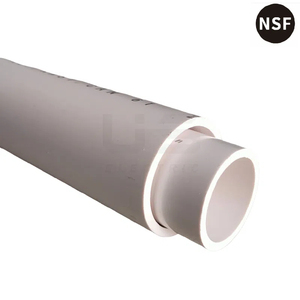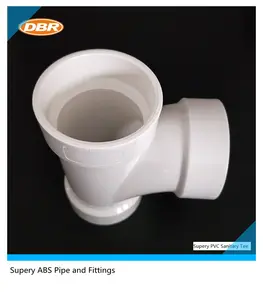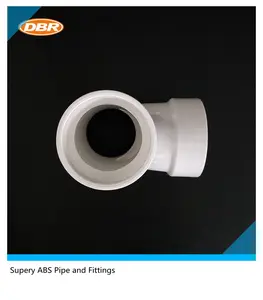(1469 products available)

















































































































































































DWV PVC pipe is a drainage and waste venting system used in plumbing. It helps remove wastewater from homes and allows air to circulate within the pipes. This system is crucial for sanitary plumbing, as it helps sewage move to treatment facilities and ventilates pipes to prevent harmful gas buildup. A PVC pipe is lightweight, affordable, and resistant to corrosion. It is popular among contractors for drainage systems. The types of DWV PVC include the following:
Sewer PVC
Sewer PVC is a popular type of dwv pvc because it is cost-effective and lightweight. It is usually used in non-pressurized applications, such as sewer and drainage systems. The pipe removes wastewater from homes and industries, transporting it to treatment facilities. It is highly resistant to corrosion and chemicals, which makes it suitable for sewage transport. The pipe comes in different diameters and sizes for various applications. It is popular among plumbers because of its affordability and ease of installation.
Schedule 40 and 80 PVC
This type of pipe is used in both pressure and non-pressure applications. It is suitable for water distribution, irrigation, and drainage. The pipes have thicker walls, meaning they can handle higher pressure. Schedule 80 PVC has even thicker walls and higher pressure ratings. The pipes are durable and have a long lifespan. They are resistant to UV radiation and rust. PVC is lightweight and easy to install using solvent welding techniques.
White PVC
White PVC pipes are used for plumbing and drainage applications. They are popular in visible applications, such as plumbing, drainage, and vent pipes. The pipes are easy to install and maintain. They offer a smooth internal surface that reduces friction and improves fluid flow. White PVC pipes are resistant to rust and UV radiation.
The features and functions of PVC pipes for drainage, waste, and ventilation include the following:
Lightweight
PVC is generally lightweight, making it easy to handle and transport. This ease of movement reduces the cost of labor during installation.
Corrosion Resistant
PVC is not prone to rust or corrosion, which allows it to last longer and require less maintenance. This feature provides a cost-effective solution for drainage and waste discharge.
Joint Integrity
PVC pipes are usually joined using cement, creating a continuous and strong flow path. The joints are usually smooth, which minimizes flow resistance and prevents leaks.
Static Load-Bearing Capacity
These pipes are capable of withstanding external pressure from soil or hydraulic loads when installed underground. The load-bearing capacity depends on the pipe diameter and wall thickness.
Temperature and Impact Resistance
PVC pipes can be used in different environments with varying temperatures. They are also resistant to impact, which prevents them from breaking due to falling objects or ground movement. However, this mainly applies to unplasticized polyvinyl chloride (uPVC) pipes.
Chemical Resistance
This type of pipe is resistant to different chemicals, including acids, bases, and salts. This feature makes them ideal for use in industrial applications and sewage systems.
Easy Installation
These pipes are easy to install due to their light weight and simple joining techniques. Their ease of installation makes them suitable for different plumbing systems.
Low Flow Resistance
The interior surface of PVC pipes is smooth, which allows easy fluid flow and minimizes turbulence. Low flow resistance improves the efficiency of drainage and waste systems.
Ventilation
DWV PVC pipes are used to provide air circulation in plumbing systems. They allow the escape of gases, especially methane, and regulate pressure in sewage and drainage systems.
DWV PVC pipes are essential in the construction industry. Therefore, it is used in different industries, including:
Construction
PVC pipes are popular in the construction industry because of their affordability and ease of installation. These pipes are used for sanitary and storm drainage systems because they are resistant to corrosion and chemicals. They are also used for wastewater disposal, venting sewage, and draining rainwater in gutters. Additionally, they are employed in conduit applications for electrical wiring in residential and commercial buildings, thus preventing electrical hazards caused by moisture.
Agriculture and farming
Apart from the construction industry, these pipes are also used in agriculture. They are used for surface and sub-surface drainage systems to control water levels in agricultural lands. This prevents waterlogging, which can damage crops. In addition, these pipes are used for irrigation systems to transport water to crops efficiently. They also carry water to livestock and poultry and are preferred due to their smooth interior, which prevents the growth of algae and other contaminants.
Telecommunication and electrical industry
PVC pipes are popular in the electrical and telecommunication industry because of their protective qualities. For example, white pvc pipe is used as conduits to protect and carry electrical wiring. The reason these pipes are used for this application is that they are non-conductive, have a high dielectric strength, and are lightweight. Moreover, they are used to house and protect fiber optic and telecommunication cables from physical damage and moisture. The smooth interior finish of these pipes minimizes the risk of fiber optic cable damage during installation.
Mining industry
PVC pipes are commonly used in the mining industry because of their lightweight and high-strength properties. They are used for dewatering in mining operations because of their corrosion resistance. They are also used for transporting water and slurries in mining operations, such as ores and concentrates. Additionally, these pipes are used for ventilation systems in underground mining operations due to their strength and rigidity.
When choosing the right PVC pipes for drainage, it is important to consider various factors to ensure the correct material and pipe size are used for the intended application. Here are some of the things a buyer should consider when choosing a DWV PVC pipe:
Pipe Schedule or Class
The PVC pipe's schedule or class rating indicates its wall thickness and strength. Schedule 40 PVC is commonly used in drainage applications due to its adequate strength and lightweight properties. However, Schedule 80 PVC may be required for applications with higher pressure or rigorous conditions. The pipes' schedule should be confirmed before making any order.
Pipe Diameter
The pipe's diameter is an important consideration when choosing DWV PVC. Larger diameter pipes are required for applications that handle high flow rates. At the same time, smaller diameter pipes are suitable for use in sink or shower drainage. The project requirements and local plumbing codes will specify the appropriate diameter.
Certification and Standards
It is important to ensure that the DWV PVC pipes meet the relevant industry standards and certifications. This guarantees that the pipes are of good quality, and their performance is acceptable. Look for certifications like ASTM, NSF, and UPC on the pipes.
Fittings and Accessories
Consider the availability of fittings and accessories needed for the DWV PVC pipe system. These include wyes, tees, elbows, and couplings. Ensure that the selected fittings are compatible with the pipe size and schedule to facilitate a seamless connection.
Pipe Lengths
PVC pipes are available in different lengths. Consider the project requirements and the number of joints and connections needed when selecting the appropriate pipe length. Choosing the right length can minimize waste and reduce the overall cost of the project.
UV Resistance
If the PVC pipe is to be installed in an area that is directly exposed to sunlight, consider choosing a pipe with UV-resistant properties. UV-resistant pipes have a smooth interior wall, which prevents the buildup of sludge and reduces the obstruction of flow.
Q: What does DWV stand for?
A: DWV stands for drain, waste, and vent. A DWV system is designed to carry water and waste to the sewers. It also carries air and vapors to prevent dangerous blockings and dumps waste safely into the sink or sewer.
Q: What is the difference between PVC and CPVC?
A: PVC and CPVC are both plastics used in pipe fitting, but they have different chemical compositions and uses. PVC is usually white or gray and is used for drain pipes, ducts, and electrical conduit. On the other hand, CPVC is usually yellowish and used for hot and cold water plumbing pipes.
Q: What is a PVC-U pipe?
A: PVC-U stands for unplasticized polyvinyl chloride. Unlike the other types of PVC pipes, these do not have any additive to make them flexible or soft. It is rigid and used for drainage, waste, and vent piping systems. It is also used in plumbing applications where fluid pressure is high.
Q: What are the properties of PVC?
A: PVC has a high impact resistance and strength. It can be used in most weather conditions without failing. It is also resistant to flame and self-extinguishing. PVC pipes are more affordable when compared to other types of piping materials. Another property of PVC is that it is lightweight and easy to handle.